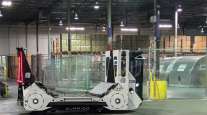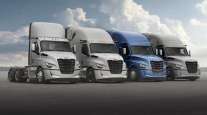Bosch Touts Electric-Hydraulic Steering to Facilitate Automated Driving

FLAT ROCK, Mich. — Executives with the North American arm of engineering company Robert Bosch showed off an electric-hydraulic steering system for Class 8 trucks that they said will aid in the transition to autonomous commercial vehicles and announced a “breakthrough” in substantially reducing emissions of nitrogen oxide from diesel.
Also shared at a demonstration for automotive and transportation reporters at Bosch’s proving grounds here on May 22 was a vision of how driverless autonomous trucks might operate among “hubs” along major interstates in longhaul service.

Bosch’s Servotwin electric-hydraulic power steering on a Class 8 tractor. (Tom Berg for Transport Topics)
Bosch’s electronics, hydraulics and equipment design and manufacturing generated $13.7 billion in revenue last year in North America, where it employs 34,500 people in its diversified activities, said the organization’s president, Michael Mansuetti. About two-thirds of that, or $9 billion, was from its Mobility Solutions division, whose accomplishments were highlighted at the event.
The German multinational engineering and electronics company is headquartered in Gerlingen, near Stuttgart.
Electric steering is the “heart” of autonomous trucks and cars because it enables lateral control that will be added to already available adaptive cruise control with automatic braking, said Jason Roycht, regional business leader for commercial and off-road vehicles. The brains are onboard computers that see traffic and road conditions via sensors, cameras and radar antennas and appropriately direct power management and steering.
Bosch’s Servotwin electric-over-hydraulic steering system provides the electronic link to the computer, while most mechanical effort is done by a normal engine-driven hydraulic pump and motor. The product keeps a truck centered in its lane while in autonomous mode as adaptive cruise control adjusts speed and brakes as needed.
Using hydraulics for the bulk of mechanical effort allows use of a relatively small electric motor, which reduces cost, said Ulrich Bidlingmaier, engineering manager for commercial vehicle steering at Bosch. Yet the motor is strong enough to provide a backup should the hydraulic system fail.
“Drivers like the feel” of the electric-hydraulic steering, he said, because it’s very light at low speeds and while standing still, making the truck easy to maneuver in terminals and at loading docks. But resistance gradually stiffens as road speed increases, so normal steering feel is restored. “And it’s all adjustable” to suit the customer.
Truck builders are not offering electric steering as yet but Bosch is talking to all of them and expects the first manufacturer to begin using the Servotwin unit within two years, Bidlingmaier said. If it were offered now, it might add a few percent to a truck’s cost, but as Roycht noted, it opens the door to autonomous operation.
Separately, cutting nitrogen oxide (NOx) emissions, a precursor to smog, by nearly 90% was accomplished by “refining existing technologies” — advanced software, fuel injection, turbocharging and exhaust aftertreatment, said Alex Freitag, director of engineering. The project in Europe saw a small diesel emit just 13 milligrams per kilometer of NOx in road testing compared with the 120 mg/l required by Euro emissions rules for 2020.
The work was done on a 1.7-liter automobile diesel, but the principles are scalable to larger diesels, including Class 8 truck engines, he said. Extra-precise controlling of the turbocharger introduced air “when it’s needed” to better modulate combustion, he said.
As usual with modern diesels, exhaust-gas recirculation was used to cool combustion and a “clean-up catalyst” was added downstream of the particulate filter to break down ammonia that slips past previous treatment. Extra dosing of exhaust gases with diesel exhaust fluid further breaks down NOx, and “hydrocarbons” (fuel) were sprayed into the oxygen catalyst to cool the exhaust.
This reduces fuel economy; while Freitag didn’t have numbers, he said a test showed an economy reduction of about 5%.
Bosch’s vision of autonomous commercial freight haulers sees hubs where trucks would tie up and depart and which would have parking space and servicing facilities, said Roycht, the regional business leader. Tractor-trailers, running singularly or in platoons of two or more, could proceed through intermediate hubs or be boarded by drivers who would take them to their final destinations. Drivers would also take newly loaded trucks to hubs where they’d be switched to autonomous operation.
Roycht showed a map of western states where hubs are located at points along major interstates. Most hubs are near major cities where commerce requires many pickups and deliveries by manned trucks. Autonomous vehicles would run between the hubs, where distances vary from 176 to 581 miles.
“These are not fun routes to staff” with drivers because of the usual time-away-from-home issues, he said. But trucks could haul cargo along these longhaul legs without drivers, alleviating the driver shortage. And local or regional driving jobs would be attractive.
Trucks equipped for autonomous operation would need some redundant components to ensure reliability and safety, which would add some cost, Roycht said. But in bad weather, an autonomous truck could pull over to wait out a snow or ice storm without tying up a driver, saving money. However, “we’d have to figure out a way to get the red triangles out.”





